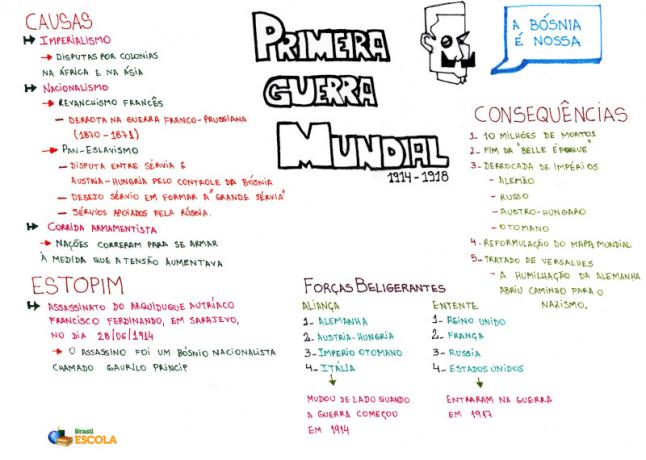THE First World War it was an armed conflict that took place between 1914 and 1918 with the main powers in Europe. Its global character was related to the fact that conflicts involve all the great powers of the Western capitalist world.
There were several factors in the outbreak of the First World War. Since the 1870s, a feeling of nationalism it was growing among the main European powers. France's defeat by Prussia in the Franco-Prussian War of 1870-1871 spurred French revanchism. But there were still other conflicts arising from nationalism. In the Balkan region, for example, several groups of different nationalities were under the political power of Empires, such as the Austro-Hungarian and Turkish-Ottoman, creating hostilities and projecting national unions, such as that of the Slavs around the Serbia.
THE dispute for colonial territories in Africa and Asia by the European powers was related to the need to maintain territories rich in raw materials necessary for the great European industry. Germany and the US were beginning to displace England as the world's only industrial power. To guarantee the sources of raw materials and the consumer markets of industrial products, there was an arms race, which strengthened the armies and stimulated the production of new weapons.
Politically there was a series of alliances between European countries in this framework of threats. formed the Triple Entente, between England, France and Russia; and the triple alliance, composed of Germany, Austro-Hungarian Empire and Italy, later coming closer to the Turkish-Ottoman Empire.
The relationship between these powers was at its maximum tension when on June 28, 1914 O archduke Francis Ferdinand, heir to the Austro-Hungarian throne, was murdered by a member of a Serbian organization in Sarajevo. After the assassination, the Austro-Hungarian Empire declared war on Serbia. Faced with this, Russia sided with Serbia, due to the fact that Serbs and Russians are Slavs and also because Russia had interests in the Balkan region.
From then on, the alliance system came into operation, with direct involvement in the conflict between Germany, France and England. The First World War had begun.
The First War can be divided into two phases: one movement war, between 1914 and 1915; and a war of position, or trench warfare, between 1915 and 1918.
Mind Map: World War I

*To download the mind map in PDF, Click here!
THE movement war it was the moment when mainly the German troops managed to move with more intensity, resulting in several victories over the Entente countries, mainly France and Russia.
THE trench warfare it became known by this name because the troops were unable to advance into enemy territory, remaining more fixed in their trenches, even with the use of planes and chemical weapons. This situation caused countless deaths among the armies. At this stage of the war, other countries on both sides came into conflict. On the Entente side, Japan, Italy, Romania and Greece participated. On the side of the Central Powers (Germany and Austria-Hungary) there was support from the Ottoman-Turkish Empire and Bulgaria.
The end of the war began to be drawn with the fall of the tsarist regime and the outbreak of the Russian Revolution. In 1918, the Bolsheviks signed a peace treaty with Germany, withdrawing from the war.
At that time, conditions were favorable for Germany, as the fighting on the eastern front diminished considerably. However, in 1918, the USA, feeling threatened by the German maritime offensive, used the downing of an ocean liner and a ship by the Germans to enter the war on the side of the Entente. Since the beginning of the conflict, the US has been supplying arms and food to the countries of that alliance. But by directly entering the conflict, the US tipped the balance against Germany, thanks to the industrial and military power held by the Americans.
From that moment, the German troops were successively defeated. In November 1918, the Kaiser German renounced the throne and an armistice was signed. With the departure of Germany from World War I, negotiations for the signing of a peace treaty began. O Treaty of Versailles it found Germany guilty of the war, which led to a series of harsh sanctions and reparations for which the country should be responsible. The sanctions created numerous social and economic difficulties for the Germans, which would be used as an argument for the start of World War II.
Others consequences of the First World War they were the disintegration of the Austro-Hungarian and Turkish-Ottoman Empires, as well as the formation of the League of Nations.
By Me. Tales Pinto
*Mental Map by Daniel Neves Silva
Graduated in History
Source: Brazil School - https://brasilescola.uol.com.br/o-que-e/historia/o-que-e-primeira-guerra-mundial.htm

